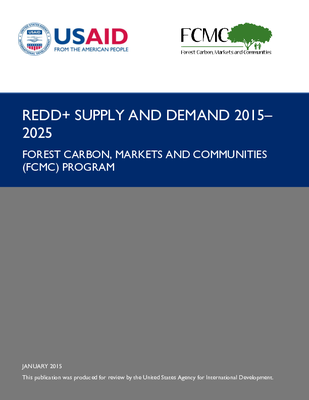REDD+ Supply and Demand 2015-2025
Forest loss in developing countries represents a significant contribution to global emissions along with significant climate change mitigation potential. How Reducing Emissions from Deforestation and Forest Degradation in Developing Countries; and the Role of Conservation, Sustainable Management of Forests, and Enhancement of Forest Carbon Stocks (REDD+) will be incentivized in a future climate agreement is still being negotiated under the United Nations Framework Convention on Climate Change (UNFCCC). One option to incentivize REDD+ is the use of carbon markets that provide economic benefits to those who reduce emissions. A voluntary market for forest credits started in the 1990s and has grown during the last decade. Bilateral and multilateral initiatives also are piloting market mechanisms and non-market results-based payments for emission reductions. This report develops a bottom-up analysis of supply using existing REDD+ projects and jurisdictional programs. It compares this supply to three scenarios of demand for REDD+ credits based on existing and emerging voluntary, regulatory and results-based payment programs. All of the results in this report can be found in an interactive graphic available online at the REDD Desk – http://theredddesk.org/markets-standards/analysis. The platform aims to give a clear picture of historic/current and projected supply and demand for REDD+ credits until 2025, from donor engagements, to the voluntary and compliance markets. The platform presents the user with a series of interactive graphs, each built with data from separate analyses carried out by USAID FCMC, GCP and Forest Trends. Each analysis focuses on a different aspect of the market for REDD+ and uses a different methodology to compile its data.
https://biodiversitylinks.org/projects/completed-projects/forest-carbon-markets-and-communities-fcmc-project/resources/redd-supply-and-demand-2015-2025/view
https://biodiversitylinks.org/projects/completed-projects/forest-carbon-markets-and-communities-fcmc-project/resources/redd-supply-and-demand-2015-2025/@@download/image/image.png
File
REDD+ Supply and Demand 2015-2025
Author(s):
Linacre, N.; O’Sullivan R.; Ross, D.; and L. Durschinger
Publication Date: 2015
DOWNLOAD FILE
Forest loss in developing countries represents a significant contribution to global emissions along with significant climate change mitigation potential. How Reducing Emissions from Deforestation and Forest Degradation in Developing Countries; and the Role of Conservation, Sustainable Management of Forests, and Enhancement of Forest Carbon Stocks (REDD+) will be incentivized in a future climate agreement is still being negotiated under the United Nations Framework Convention on Climate Change (UNFCCC). One option to incentivize REDD+ is the use of carbon markets that provide economic benefits to those who reduce emissions. A voluntary market for forest credits started in the 1990s and has grown during the last decade. Bilateral and multilateral initiatives also are piloting market mechanisms and non-market results-based payments for emission reductions. This report develops a bottom-up analysis of supply using existing REDD+ projects and jurisdictional programs. It compares this supply to three scenarios of demand for REDD+ credits based on existing and emerging voluntary, regulatory and results-based payment programs. All of the results in this report can be found in an interactive graphic available online at the REDD Desk – http://theredddesk.org/markets-standards/analysis. The platform aims to give a clear picture of historic/current and projected supply and demand for REDD+ credits until 2025, from donor engagements, to the voluntary and compliance markets. The platform presents the user with a series of interactive graphs, each built with data from separate analyses carried out by USAID FCMC, GCP and Forest Trends. Each analysis focuses on a different aspect of the market for REDD+ and uses a different methodology to compile its data.


